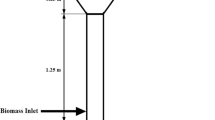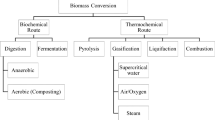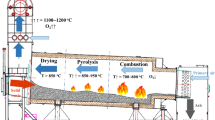Abstract
To investigate heat transfer of char from waste tire pyrolysis, the cooling of char was simulated by the computational fluid dynamics. To scrutinize the heat transfer characteristics, bed height, temperature of cooling wall, and mixing time were selected as calculation parameters. From the results, increasing the char bed height from 0.005 to 0.02 m, the total heat transfer is decreased as from 45.5 to 26.5 J. As the char bed height is further increased from 0.02 to 0.06 m, the total heat transfer is decreased from 26.5 to 9.1 J. The char bed height affects the total heat transfer significantly. The total heat transfer decreases from 15.9 to 14.0 J as the temperature of cooling wall increases from 273.15 to 323.15 K. The total heat transfer mildly depends on the temperature of cooling wall. The particle mixing time increases from 10 to 120 s and the total heat transfer decreases from 28.6 to 22.6 J. It is noted that the particle contact is enhanced between char particles as well as the particles and cooling wall as the particle mixing time decreases. Consequently, heat transfer is augmented.










Similar content being viewed by others
References
Mui ELK, Ko DCK, McKay G (2004) Production of active carbons from waste tyres-a review. Carbon 42:2789–2805
Juma M, Koreňová Z, Markoš J, Annus J, Jelemenský Ľ (2006) Pyrolysis and combustion of scrap tire. Petroleum Coal 48: 15–26
Willams PT (2013) Pyrolysis of waste tyres: a review. Waste Manage (Oxford) 33:1714–1728
Cunliffe AM, Williams PT (1998) Properties of chars and activated carbons derived from the pyrolysis of used tyres. Environ Technol 19:1177–1190
Li SQ, Yao Q, Chi Y, Yan JH, Cen KF (2004) Pilot-scale pyrolysis of scrap tires in a continuous rotary kiln reactor. Ind Eng Chem Res 43: 5133–5145
Galvagno S, Casu S, Casabianca T, Calabrese A, Cornacchia G (2002) Pyrolysis process for the treatment of scrap tyres: preliminary experimental results. Waste Manage (Oxford) 22:917–923
Darmstadt H, Roy C, Kaliaguine S (1995) Characterisation of pyrolystic carbon blacks from commercial tire pyrolysis plants. Carbon 33:1449–1455
Tang L, Huang H (2005) Thermal plasma pyrolysis of used tires for carbon black recovery. J Mater Sci 40:3817–3819
Oyedun A, Lam M, Fittkau M, Hui CW (2012) Optimisation of particle size in waste tyre pyrolysis. Fuel 95:417–424
Cheung KY, Lee KL, Lam KL, Lee CW, Hui CW (2011) Integrated kinetics and heat fl ow modelling to optimise waste tyre pyrolysis at different heating rates. Fuel Process Technol 92: 856–863
Yao Z, Li M, Zhao L, Meng H, Cong H, Hou S (2015) Design and experiment on biochar second-stage cooling system with spiral-flow. Trans Chin Soc Agric Eng 30:223–228
Xu XQ, Wang YG, Chen ZD, Bai L, Zhang KJ, Yang SS, Zhang S (2015) Influence of cooling treatments on char microstructure and reactivity of Shengli brown coal. J Fuel Chem Technol 43:1–8
Choi HS (2015) Wall heat transfer of a small blunt body immersed in a fluidized bed. Numer Heat Transf Part A 68:288–311
Syamlal M, Rogers W, O’Btien TJ (1993) MFIX documentation theory guide. U.S. Department of Energy. Office of Fossil Energy. Morgantown Energy Technology Center
Mills AF (1992) Heat transfer. Richard D. IRWIN INC, Boston
Liu B, Li Y (2016) Simulation of effect internals on particulate mixing and heat transfer in downer reactor using discrete element method. Powder Technol 297:89–105
Xie Q, Chen Z, Hou Q, Yu A, Yang R (2016) DEM investigation of heat transfer in a drum mixer with lifters. Powder Technol. doi:10.1016/j.powtec.2016.09.022
Acknowledgements
This work was supported by the New & Renewable Energy of the Korea Institute of Energy Technology Evaluation and Planning (KETEP) grant funded by the Korea government Ministry of Knowledge Economy (No. 20143010091790). This work was supported by the Korea Institute of Energy Technology Evaluation and Planning (KETEP) and the Ministry of Trade, Industry & Energy (MOTIE) of the Republic of Korea (No. 20164030201250).
Author information
Authors and Affiliations
Corresponding author
Rights and permissions
About this article
Cite this article
Park, H.C., Choi, H.S. & Kwak, YH. Numerical study of heat transfer characteristics of char from waste tire pyrolysis. J Mater Cycles Waste Manag 19, 1077–1084 (2017). https://doi.org/10.1007/s10163-017-0598-0
Received:
Accepted:
Published:
Issue Date:
DOI: https://doi.org/10.1007/s10163-017-0598-0




